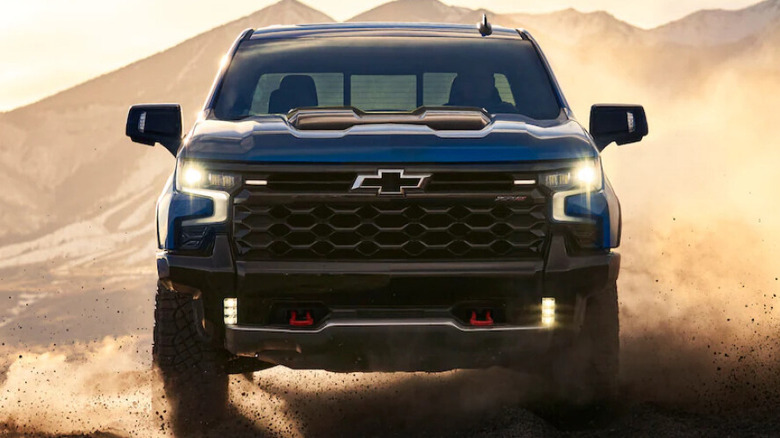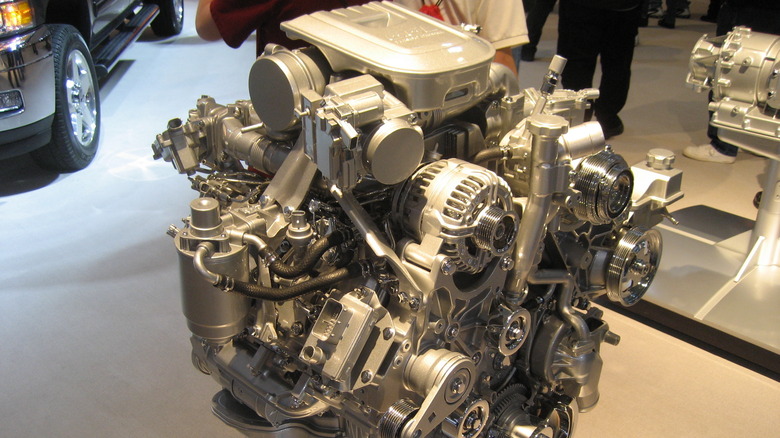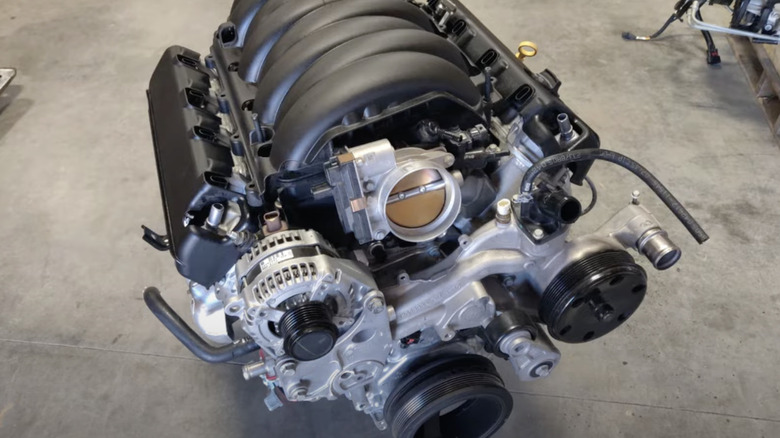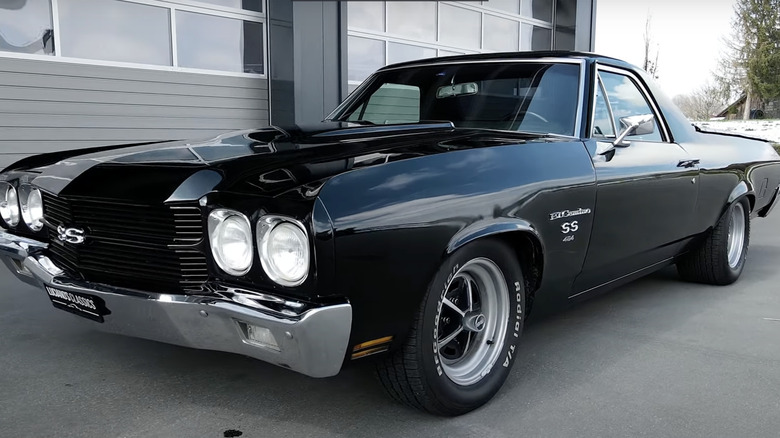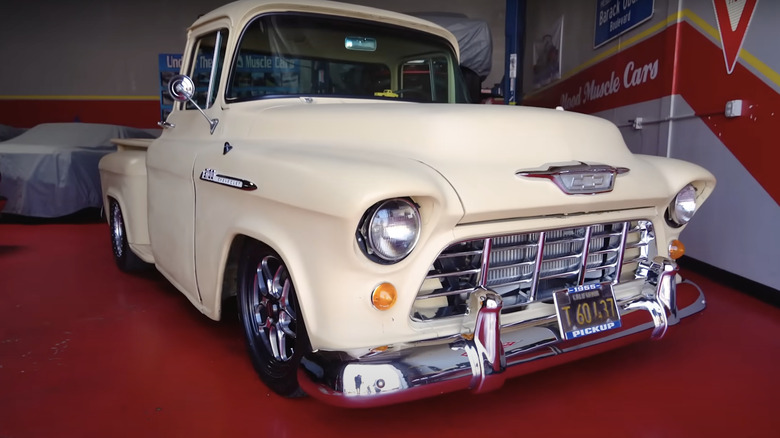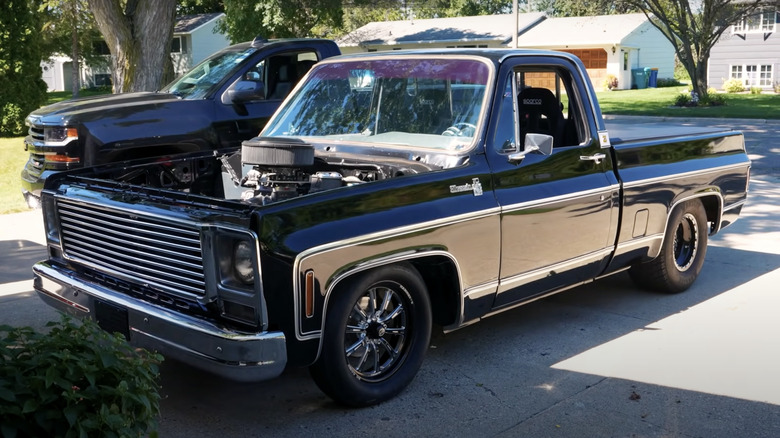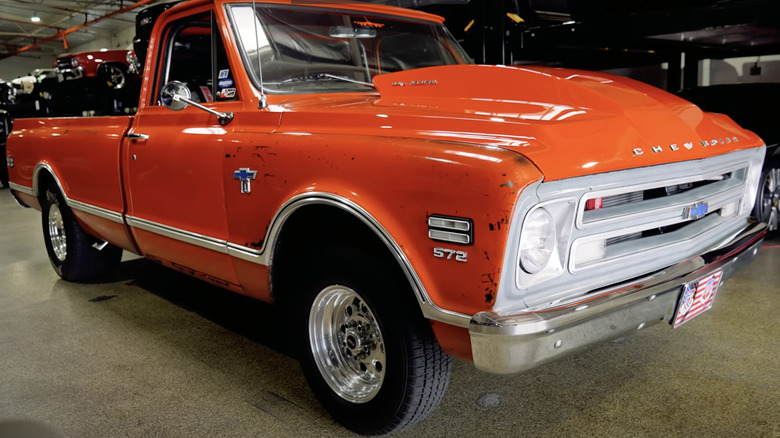6 Of The Most Powerful Engines Ever Put In A Chevy Pickup Truck
Chevrolet has been building trucks for more than a century. Its first foray into that segment was the 1918 Model T, not to be confused with Henry Ford's iconic car of the same name. Chevy's Model T was partially a do-it-yourself offering, consisting of only a chassis and frame. That left the owner to install their own cab and body, which led to some creative configurations. That initial model was powered by a 224 cubic inch (3.7 liter) I4 engine that put out just 36 horsepower and came in half-ton and one-ton versions.
In the 100-plus years since then, Chevy trucks have evolved along with automotive technology. In 1929, Chevy introduced the straight-six engine and enclosed cab to the pickup truck world, and the Task Force series that debuted in 1955 could be purchased with GM's new small-block V8 engine. The legendary and long-running C and K series first appeared in 1967 and lasted through 2002, by which point those badges had been replaced by the Silverado. The 2025 Silverado comes with several engine options, all of which dwarf Chevy's early engines in terms of output. Intrepid Chevy owners haven't stopped at what they can get from dealerships, though. Some of them use modified engines to take their trucks beyond the realms for which they were originally intended; we're going to take a peek into the best of both of those worlds and show you the most powerful Chevy trucks to ever hit the road.
The Duramax 6.6-liter diesel now makes 470 horsepower
General Motors began developing the Duramax line of diesel engines in 2001 in partnership with Isuzu, and its first engine produced was a 6.6-liter V8. That motor is still available on the 2025 Silverado 2500 Heavy Duty (HD) pickup and produces an impressive 470 horsepower and 975 pound-feet of torque. Chevy boasts a towing capacity of up to 36,000 pounds, and Edmunds tested the four-ton beast at 6.8 seconds from 0-60 miles per hour.
That's more than twice the time the quad-motor Rivian R1T takes to make that same sprint, but the Silverado with the 6.6-liter Duramax can haul more than three times as much as the Rivian. On the slightly smaller Silverado 1500, the biggest of the four engine choices is a 6.2-liter Ecotec 3 V8 that puts out 420 horsepower and 460 pound-feet of torque. Those aren't quite Duramax numbers, but they still rank pretty high on Chevy's all-time list of beefy stock truck engines.
[Featured image by Dana60Cummins via Wikimedia Commons|Cropped and scaled|Public domain]
The 6.2-liter Ecotec3 has some cutting-edge technology
The 6.2-liter Ecotec3 is the successor to the 5.3-liter Ecotec V8 that GM produced from 2014 through 2019 for use in its trucks and SUVs. This engine carries the L86 and L87 designations, with the latter version first appearing in 2019 Silverado and GMC Sierra High Country and LTZ pickups. Both 6.2-liter Ecotec3 engines are naturally aspirated and feature direct fuel injection and cylinder deactivation technology to help save fuel.
The block and heads are made of lightweight aluminum, and the crank and camshafts are steel for added strength. For the 2025 model year, you can get the 6.2-liter Ecotec3 on SIlverado RST Crew Cab, LT Trail Boss, ZR2, and four-wheel drive LTZ and High Country trucks. The smaller 5.3-liter Ecotec 3 V8 is also still available, although it makes a more modest 355 horsepower and 383 pound-feet of torque. That engine is the base offering on Silverado LTZ and High Country trucks and can be added as an option on the WT Crew and Extended Cab, the Custom Trail Boss, the LT, the RST, and the LT Trail Boss.
The 1970 El Camino SS was an absolute beast
The El Camino coupe/pickup hybrid debuted in 1959 and lived through 1987 as half-muscle-car and half-truck, but the 1970 El Camino SS was so special we're going to ignore the car half and include it here. Only about 500 El Caminos got the Corvette's 454 cubic inch LS6 V8 that year, making this a rare beast indeed. This engine produced nice round numbers of 450 horsepower and 500 pound-feet of torque and smoked the rear tires via a Muncie four-speed manual gearbox. Even with a curb weight of 3,840 pounds, this was enough to whip the El Camino down the quarter-mile strip in 13.2 seconds.
A fully restored 1970 El Camino SS with the original LS6 454 engine sold at auction last year for $275,000, which is more than four times the top-end value that JD Power quotes for a run-of-the-mill example. If you can find — and afford — one of the few remaining specimens, there are plenty of ways to boost the 454's power numbers even higher, like cam upgrades, performance heads and exhaust systems.
One hot rod '55 Chevy pickup makes 1000 HP
400-500 horsepower is nice and will certainly make any Chevy truck haul butt, but some modders didn't stop until they pushed their powerplants into four-digit horsepower territory. One such craftsman is a part of the crew at Hood Muscle Cars in Los Angeles, and worked wonders with a 1955 Chevy 3100 pickup. The grey-bearded gentleman goes by Blank, and caught the street racing bug and customizing bug from his high school auto shop teacher, Mr. Grey. He told Autotopia LA in 2023 that despite having done extensive work to the suspension and frame, he had further plans for the rear end and underpinnings, and he was still in "the beginning stages" of building out the truck.
The engine is a 5.3-liter LS series V8 with a pair of custom built turbochargers sitting in the front corners of the engine bay, but Blank claims he gets more than 1,000 horsepower without any added turbo boost. He said the whopping power output is creditable to the machined heads and extra spring pressure provided by the upgraded valve system he installed.
Rob McGregor's Chevy pickup has been in the family for 50+ years
Rob McGregor's father, Butch, bought a 1979 square-body pickup from a dealership in 1981 with 5,000 miles on the odometer and a noisy water pump. Butch and Rob made extensive upgrades to the stock 350-inch motor in 1989, and in 2011, they replaced it with a 454 cubic inch big block V8 with a crankshaft from a 396. Rob said that the engine was capable of about 630-650 horsepower, but he blew the motor later while doing burnouts with a friend. The truck then sat idle for seven years while Butch and Rob contemplated a new build.
By that point, Butch had died, and the truck and 565 cubic inch motor Butch had purchased for it was handed down to Rob. He and two friends have since made multiple rounds of upgrades and improvements to the engine, including mounting a 1,150 cubic foot per minute Holley Dominator carburetor to the intake. Rob said the engine ran at 7,500 revolutions per minute during dynamometer testing, where it registered 1,008 horsepower. The truck is still running strong, and Rob said he has learned valuable life lessons during his many years of working on the Chevy. "It's amazing what a vehicle will do for you as far as growing, and this truck has done that for me."
Jake Black's classic Chevy pickup makes 803 horsepower
For our next high-potency Chevy Truck, we go to Utah resident Jake Black, who started with a 1968 C10 pickup with 32,000 miles on the odometer. When he bought it, the truck had been garaged for nearly its whole life and still had the stock 307 cubic inch engine mated to a column-shifted three-speed transmission. Jake swapped those out for a 468-inch big-block V8 that he promptly blew and replaced with a 572-inch monster with hot cam, beefier crank and pistons, and ported heads with upgraded valves. That engine's 803 horsepower was too much for the Tremec TKL-600 transmission that sat behind it, so he replaced that gearbox with a Tremec TKX, which is rated to handle up to 980 pound-feet of torque.
To put that power to the road, Jake installed a custom-built rear 9-inch axle that was originally made for trucks built by a rival manufacturer whose name he almost couldn't bring himself to say on camera for Autotopian LA. (Hint: it starts with"F" and rhymes with "Bored.") The nine-inch rear end has served him well, though, and he eventually acknowledged that it was acceptable to allow the beefy axle to sully the purity of his almost-stock Chevy chassis.
